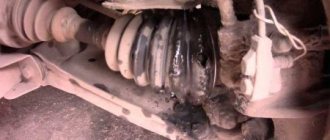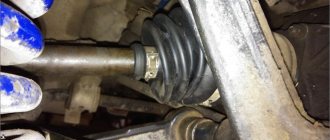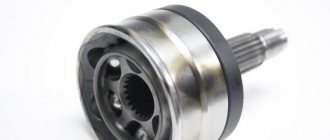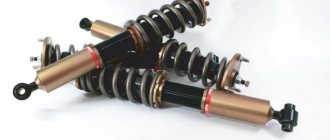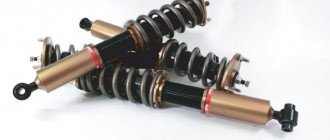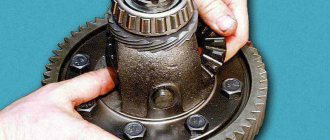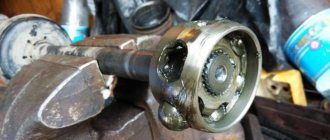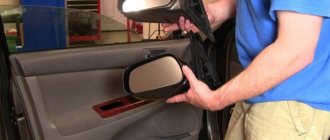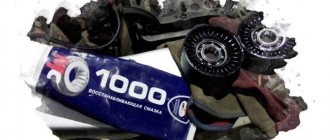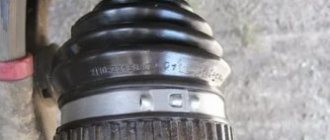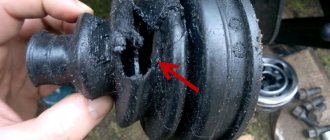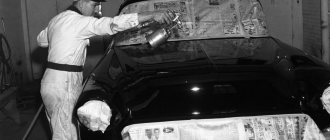The abbreviation CV joint is an abbreviation for the phrase “constant velocity joint.” In driveshafts of rear-wheel drive cars, similar functions are performed by hinges consisting of a cross and cups with needle bearings. The only difference between them is that the cross provides a much smaller degree of freedom than the CV joint. But the cheapest CV joint is much more expensive than the most expensive spider. This circumstance increases the desire to extend its service life. For which, of course, you can use good lubricant and monitor the condition of the boot. Therefore, the question of what is the best lubricant for CV joints is natural. Timely replacement of a torn boot will also extend the life of the grenade if the lubricant is changed at the same time.
CV joint design
At the beginning of the last century, many CV joint designs were developed, which are used to this day. For example, cracker or cam, cam-disk, ball with dividing grooves or with dividing levers, with spherical rollers and a fork, paired cardan shafts. All CV joints have both advantages and disadvantages. The performance of each design is better for some conditions and not so good for others. Therefore, there is no question which design is more successful.
For external drive joints of modern fast passenger cars, the characteristics of a ball joint with 6 balls turned out to be better. The CV joint body and the inner ring under the separator, which keeps the balls from falling out of the CV joint, have the same number of grooves for them. The connection of the inner ring with the drive and the CV joint housing with the hub is splined. At large angles of rotation of the drive wheels, the maximum permissible torque transmitted by the hinge is much less than at small angles. Therefore, for long-term trouble-free operation of the CV joint, it is necessary to prevent it from working with a heavy load in the extreme positions of the steering wheel. Each CV joint is necessarily protected by a boot.
Tripoids are often used as internal grenades. They are less mobile, but more wear-resistant, since needle bearings are used in their design.
What is a tripod?
The CV joint consists of two autonomous units:
- the internal assembly is attached directly to the drive axle;
- the second is integrated into the drive wheel hub.
They are used to equalize angular velocity with large balls moved along special grooves. Depending on the car model, a specific lubricant is used for the internal CV joint and external analogue. The disadvantage of the mechanical design is that it does not provide for axial movements of the suspension. Needle joints have these properties.
They were called tripods, from the English word tripod. Hinges of this type compensate for the lack of ball analogues. The angular velocity is equalized due to the movement of the rollers along special channels during turns or axial instability.
Since the inquisitive thoughts of engineers do not stagnate, CV joints have been created with hinges of a ball mechanism that allows for axial movements. As an example, it is worth citing the domestic car of the Volzhsky Automobile Plant, modification 2108-2110. They were produced with a needle version and a ball version.
Lubricant composition for CV joints
For modern ball CV joints, lithium grease is used, most often based on mineral oils containing molybdenum disulfide as an antifriction additive (from 3 to 5%). Due to its black color, it can be confused with graphite grease, which should never be used in CV joints. Due to its weak anti-friction qualities, regular lithol cannot be used to lubricate CV joints either.
For tripoids, you cannot use the lubricant described above. For them, you can only use a special barium-based lubricant. One of its differences is the wide temperature range in which it can operate. After all, in winter the drive cools down to -30, and in summer it heats up to +160 ○ C.
Greases are made by thickening the base oil with various thickeners, which can be salts of higher carboxylic acids: lithium, calcium, aluminum, sodium and others. Inorganic thickeners, such as bentonite clay, and synthetic thickeners, for example, polytetrafluoroethylene, can also be used. As a rule, the lubricant contains up to 90% base oil, the remaining 10% consists of a thickener and various additives that determine the main characteristics of the substance.
In what cases does the CV joint lubricant change?
- When replacing a torn boot. In this case, it is necessary to change the lubricant
- After 100 thousand kilometers or after 5 years of operation of the CV joint.
If the drive is crunchy, it is too late to change the lubricant in it. The drive itself needs to be replaced. This is explained by the fact that if the hinge crunches, it means that it already has significant wear and no matter how much you change the lubricant in it, it will not get any better. To determine which of the joints has crackled, you need to select a flat asphalt area and drive along it, turning the steering wheel all the way to the left, and then all the way to the right. At this time, the assistant, being outside the car, must evaluate in which case the crunch is louder. If the sound is louder when the steering wheel is turned to the left, then the left outer drive needs to be replaced. When the crunch is louder with the wheels turned to the right, you need to change the right outer drive.
Kinds
Lithium:
This type of lubricant is very common in our country. Lithium compounds have excellent anti-friction properties and also significantly reduce the load on the hinge components. Lithium greases are highly water resistant and dust resistant. The need for replacement depends on its quality; on average, it is recommended to do this every 50-60,000 km.
Litol CV joint-4 from Gazprom Neft, judging by the reviews, is one of the leaders in the segment. It is replaced approximately every 100,000 km.
Molybdenum:
Abroad, most manufacturers have switched to molybdenum disulfide as the basis for CV joint-4 lubricant. This type has better anti-corrosion properties, as well as higher extreme pressure properties. Its only drawback is hydrophobia. If moisture gets into the lubricant, it instantly loses its effectiveness. Replacing such lubricant is required on average every 100,000 km.
The most popular among auto mechanics is the CV joint-4 from Liqui Moly.
Lubricant for internal CV joints
Previous types of lubricant were relevant for external hinges and internal hinges with ball bearings, but are not suitable for internal ones due to their higher temperature (160). Most internal joints use needle bearings. Their lubrication should be carried out with a polyurea-based composition, which does not contain the slightest solid particles. Car owners highly praise the Castrol LMX CV joint, which is designed specifically for needle bearings.
Among domestic analogues we can highlight the super-4ml CV joint.
How to properly change the lubricant in CV joints
Correct lubricant replacement. Replacing the lubricant in CV joints is done due to its contamination after the boot ruptures or its service life expires when it contains a lot of wear products. It is necessary to completely remove the old grease from the joint to eliminate the possibility of increased wear of the CV joint. To do this, it should be disassembled and thoroughly wiped with a clean rag. It will not be possible to wash it without disassembling it, because the grease is extremely difficult to wash off.
There are usually no difficulties with disassembling the internal hinge, so we will describe disassembling the external one. If you do not have a special tool for removing the outer hinge, then remove the drive assembly and clamp it in a vice. Remove the clamps from the boot. When removing, try not to damage them; the factory ones are usually better than those that come with the new boot. If the cover is torn, cut it off with a knife; if not, slide it onto the drive rod. Use a hammer to knock the joint off the drive using a drift on the inner ring. Turn the inner ring with the separator so that the holes in the separator are visible, and the symmetry axes of the separator and the housing will be perpendicular. Using a flathead screwdriver, remove all the balls from the separator. In the separator, two of the six holes are longer than the others. Turn the separator so that they are pressed against the walls of the housing and remove the separator with the inner ring from the housing. After adjusting the position of the inner ring, remove it from the separator. Remove any remaining grease from the parts as best you can, and the hinge can be assembled.
Insert the inner ring into the cage. Orient the cage so that the long holes in it are pressed against the hinge body, and insert the cage and ring into the body. Insert the balls into the holes of the separator and rotate the inner ring so that the hole for the drive is located along the axis of the housing. The unit requires from 120 to 150 g of lubricant. How much will fit in your case depends on the size of the hinge.
To properly fill the joint with lubricant, clamp it in a vice with the drive hole facing up. If you bought the lubricant for it in tubes, then press it into the hole under the drive, pressing the tube more tightly to the ring, until it appears between the separator and the housing. If you have it in a different package, then put it on with a spoon and press it into the hole for the drive with a cylindrical object of suitable diameter; The filling criterion is the same.
When installing the boot, do not put a lot of grease into it, otherwise it will tear it apart while the boot is working. Before tightening the boot clamps, lubricate the grooves for them with lithol.
Lubricant testing
The tests included the following checks:
- Rinse with water and protect the unit from penetration of this liquid into it.
- Fluidity when temperature rises to 180 ○ C.
- Lubricating properties.
- Resistance of the lubricating film to pressure.
- Wear of metals protected by lubricant.
Places during the testing process were not allocated to the competitors, they were simply graded, so you will have to determine which lubricant is better. Below are the results of testing of ball joint greases by one of the independent researchers.
- CV joint-4 manufactured by AZMOL JSC, Berdyansk. Rated "Good".
- CV joint-4M manufactured by Sibneft OJSC Omsk Oil Refinery. Rated "Good".
- LM 47 Langzeitfett manufactured by Liqui Moly GmbH (Germany). "Excellent" rating.
- Chevron Moly Grease EP 2 manufactured by Chevron Products Company, San Francisco (USA). "Excellent" rating.
- Castrol MS/3 Spezialfett manufactured by Castrol (Germany, Hamburg). "Excellent" rating.
- BP Energrease L21M manufacturer British Petroleum British oil and gas company.
Properly lubricate the tripod joint
Despite the fact that the design of the tripoid hinge is based on the use of needle bearings, lubricating them with 158 grease, which is usually used for needle bearings, is strictly prohibited. The fact is that a lithium thickener is used for its manufacture, and it can work at a temperature no higher than 120 ○ C, and the temperature of the internal grenade reaches 160 ○ C. Since the lubricant for the internal grenade is quite liquid, it is better to pour it inside the boot installed on drive, and then assemble the tripoid. You need to fill in from 100 to 130 g of lubricant. More precisely, to the question, “how much?” the manufacturer will answer.
Lithium
They arose almost immediately after the CV joints themselves. As a result, such a substance is in good demand.
The composition is based on a lithium solution and organic acid. The result is a yellowish, viscous substance that thickens as temperatures drop, making it much more difficult to spread in winter. Using compositions of this type, it is possible to reduce the load on drive elements by a couple of tens of times.
At the same time, we are pleased with the high preservative properties of the substance. It prevents dust, dirt, moisture and other elements from penetrating metal elements. At the same time, such compositions are very aggressive, so they can dissolve anthers. Read the manual for your car. It indicates whether the use of lithium substances for lubricating joints is permissible.
Recently, lubricants of this type have become somewhat less popular, giving way to more innovative options. At the same time, they can still be found on the market. The most popular options now are XADO, Very Lube and RENOLIT.
What functions does a lubricant perform?
Motorists know that lubricants used in car components and joints not only reduce friction and prevent premature wear of car parts. But they also reduce the load on the parts, as a result of which the parts rotate freely and the car continues to move without friction or load.
CV joint lubrication allows you to reduce fuel costs and losses in transmission operation. A very important property is to prevent the spread of corrosion. It is during corrosion that the operation of CV joints is accompanied by the appearance of an unpleasant knocking noise, which intensifies when the steering wheel is turned and torque is not transmitted effectively. To prevent CV joints from getting dirty, boots are used. It is important to prevent grease from getting on the boots; they are made of rubber or plastic, which is eaten away upon contact with grease.
Molybdenum
A more progressive option, which is made from the same lithium soap, only now the additive is molybdenum disulfide. Lubricating properties are the same as the previous version. At the same time, molybdenum compounds have one important advantage - they have high anti-corrosion properties.
This was achieved by using metal salts in the composition, which replaced some acids. In addition, the substance is completely safe for rubber and plastic elements, so it will not lead to premature wear of the boot.
One of the disadvantages of such a substance is its low resistance to moisture. As a result, if even a little water gets under the boot, due to certain chemical reactions the composition turns into an abrasive. This only promotes friction, which leads to a number of CV joint failures. To prevent such a situation, it is necessary to regularly check the node.
There is also an opinion that the use of molybdenum lubricants leads to the restoration of damaged transmission components. This statement is incorrect, so if you hear a crunching noise in the CV joint, it is better to contact the service center technicians.
Among the most popular options available in our country are CV joints-4 and LM47 lubricants.
When does the CV joint lubricant change?
The lubricant is replaced in the following cases:
- torn boot and its replacement;
- replacing the angular velocity adjustment hinge;
- CV joint operation for more than 5 years;
- mileage over 100 thousand kilometers.
You should not apply a large amount of lubricant, this will not provide better protection, but will only increase the likelihood of damaging the anthers. There should be enough lubricant so that the part is completely lubricated and no grease drips from it.
How much grease should I fill into the CV joint? It all depends on whether it is indoor or outdoor. For an internal CV joint, 100-110 grams is enough, and for an external CV joint, 70-80 grams.
Disassembling the unit and lubricating it
Disassembly of the internal CV joint (TRIPOD)
Attention! Remember the locations of the parts of the assembly. Make marks. Everything should go back to its place, especially the balls.
Parsing algorithm for replacement:
- Unscrew the hub nut.
- Discard the balls.
- Loosen the inner CV joint boot.
- Bend the posts.
- Get the part.
- Remove the retaining ring.
Lubrication
Attention! Prepare materials in advance to remove old grease. Solvent must not be used.
The removed parts must be cleaned to a shine. It is advisable to use paper to remove old grease, and a towel for final cleaning and polishing.
Algorithm for lubrication of parts during its replacement:
- Fill the bottom of the grenade with the mixture.
- Assemble the hinge.
- Install the retaining ring.
- Drive in the axle.
- Check that the TRIPOD marks match.
- Pour the mixture into the entire assembly.
- To get the lubricant out, put a small amount of it in the boot.
Types of lubricants
Along with the question: which CV joint is better, motorists are faced with the problem of choosing a lubricant. There are many different lubricants for caring for CV joints and each has its own advantages and disadvantages. Here we will consider only those that have proven themselves and are considered most suitable.
Lithium based greases
The most common lubricants are lithium foam lubricants in organic acid. These lubricants are yellowish in color and a little thick. In the cold they thicken even more, as a result of which spreading them on the part becomes a little problematic. This problem makes itself felt at sub-zero temperatures at the beginning of driving - you can hear the tapping of the CV joints and suspension. When all the mechanisms warm up, the car's operation is improved. Such lubricants reduce friction well and reduce the load on components by up to 10 times.
The big advantage is the neutralization of trapped dust and the ability to prevent moisture from reaching the parts. Another feature of lithium greases is that they are fully compatible with polymers that are installed on CV joints, with the exception of some hard plastics that are present on modern cars.
The disadvantage of lithium greases is that most of them have poor corrosion resistance. This is what you need to pay attention to first when choosing this type of lubricant.
Lithium-based lubricants can be used such as Litol-24, Renolit, Xado. These lubricants have already proven themselves on the market and have the most suitable properties.
Molybdenum disulfide based lubricants
Barium based lubricants
Recently, scientists have created many different lubricants for CV joints, but only one type combines the advantages of lithium and molybdenum without their disadvantages - barium lubricants. The main advantage of such lubricants is their high resistance to moisture. For example, if the boot ruptures, the barium-based lubricant can not be changed until a lot of dirt has accumulated in it.
Equally important is that such barium grease protects CV joints from all types of corrosion and does not dissolve boots made of any polymers. The only thing that this type of lubricant cannot boast of is the price and low resistance to negative temperatures. Barium-based lubricants are much more expensive than lithium and molybdenum lubricants due to the complexity of their manufacture and are much less common.
On the market you can find only one domestically produced barium-based product - ShRB-4.
Manufacturers ShRB-4
In the Soviet years, the production of lubricants was carried out exclusively by the Berdyansk Experimental Oil and Oil Plant, which, after the collapse of the USSR, became the Azmol Public Joint Stock Company, located outside the Russian Federation. Now this enterprise is called AZMOL British Petrochemicals (AZMOL British Petrochemicals).
In the Soviet Union, ointment for CV joints was not in particularly great demand for two reasons. Firstly, the number of cars owned by citizens was much smaller than at present.
Secondly, thanks to the durability of the lubricant, one can of ointment was enough for each car owner for a long time, so there was no need to buy it often.
Today, ShRB-4 lubricant is produced in Ukraine by the above-mentioned Berdyansk enterprise under the Agrinol brand, packaged in 400-gram jars.
In Russia, the production of ShRB-4 is carried out, located in the village of Starosyrovo in the Novomoskovsky administrative district of Moscow. This company packages the product in cans of twice the volume - 0.8 kg each.
How to choose a lubricant
Grease lubricating CV joints has a different appearance. Considering all the features and internal set of characteristics of lubricants, the most suitable option today is lubricants based on molybdenum disulfide. A good option, suitable for all cars, minimizing friction in the components and resistant to corrosion, with minimal impact on the boot. By lubricating each CV joint unit, you will extend its life. But still, when choosing a lubricant, you should follow the recommendations in the instructions for your car.
Lubricant for CV joints exists for good performance of the equal-velocity joint, reduces the level of rubbing, increases the efficiency of the system and prevents rust from forming on some parts of the joint. Many car owners are wondering what lubricant to use for CV joints? We have selected for you the material and their functions for comparison, which are in the range of lubricants. Also in the text we provide information for their use in practice, and what people say based on personal experience of using the six most common lubricants by many drivers.
We will look at these aspects:
- types of CV joints and the necessary qualities for lubrication
- types of lubricants used for angle speed joints
- type of lubricant used in severe conditions
- how to change the lubricant in a CV joint
- lubricant models for internal and external CV joints
- the best lubricant
characteristics of CV joints, its properties and varieties
Before moving on to describing the properties of lubricants, let's talk about CV joints. This is necessary in order to know what qualities lubricants for “grenade” lubricants should have, as CV joints are popularly called, and what composition to use in certain cases. The hinge exists in order to transmit torque from one axis to the second if it is located at an opposite angle. The value can reach up to seventy degrees.
Over the course of the existence of CV joints, the following were made:
Ball . These are the most popular, specifically their analogue “Rtseppa-Lebro”.
Tripod . They are often used in the Russian automotive industry as internal CV joints (those that are installed on the side of the power drive).
Crackers (also called cam ones). They often get hot, so they are installed in trucks where the rotation angle is low.
Cam-disk . These are also installed on trucks and construction vehicles.
Twin cardan shafts . Typically used on construction equipment and trucks.
At significant angles in the middle of the axes, the effect of the hinges decreases. In other words, the value that transmits the torque of the joint is smaller. Therefore, avoid heavy loads with the wheels deployed.
A special feature of each angle velocity joint is the large impact loads. They appear when the car starts driving, climbs, rides over potholes, etc. With special CV joint lubricants, all bad consequences are neutralized.
The current hinges work at the same angle speeds a lot (if you maintain the tightness of the boot), and even as long as the car will drive. The lubricant must be changed when replacing the boot or the entire CV joint. Although according to the manual, changing the CV joint lubricant should be done after 100,000 km of driving or once every five years (whichever is required earlier).
Characteristics of lubricants for joints of equal angular speeds
Since there are difficult operating conditions for the hinges, CV joint lubricant will protect the system from the negative and provide:
- Increased coefficient of rubbing of parts inside the hinge;
- Minimizes wear of some parts of the CV joint.
- Will reduce the mechanical load on the component parts.
- Protects the surface of metal parts from corrosion.
- Neutral reaction with rubber joint seals (boots, gaskets) in order not to spoil them.
- Repels water.
- Long lasting use.
RAVENOL Mehrzweckfett mit MoS-2
This product is produced in factories located in Germany. The basis of the composition is molybdenum disulfide. Operation of the substance is indicated at a temperature range of -30-+120 degrees.
The composition is resistant to moisture, including salt water. The cost is 2-3 times higher than in the case of domestic analogues, but here you pay for quality.
Products are manufactured in Ukraine. The option has good quality and a fairly affordable price. First of all, the models are used to protect external CV joints.
The composition does not contain molybdenum disulfide, but there are revitalizants - substances that significantly slow down the wear and deformation of not only the hinge itself, but also a number of other components and mechanisms. The lubricant can withstand temperatures from -30 to +140-150 degrees
